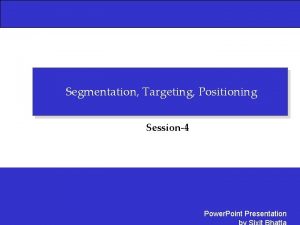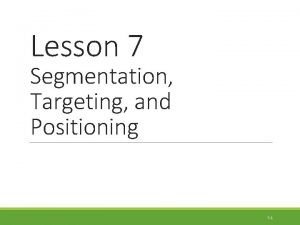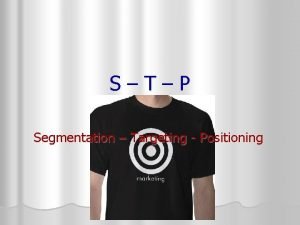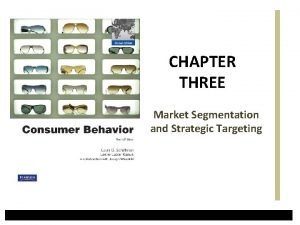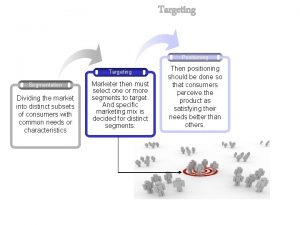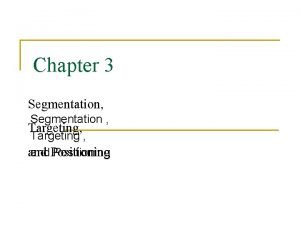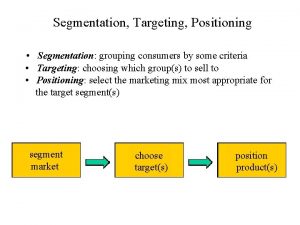Segmentation Targeting Positioning Session4 Power Point Presentation Mass





























- Slides: 29

Segmentation, Targeting, Positioning Session-4 Power. Point Presentation

Mass Market

Whom do you sell these products

Effective Targeting Requires Ø Identify and profile distinct groups of buyers who differ in their needs and preferences. Ø Select one or more market segments to enter. Ø Establish and communicate the distinctive benefits of the market offering.

Steps in Market Segmentation, Targeting and Positioning Market Segmentation 1. Identify bases for segmenting the market 2. Develop segment profiles Market Targeting 3. Develop measure of segment attractiveness 4. Select target segments Market positioning 5. Develop positioning for target segments 6. Develop a marketing mix for each segment

Four Levels of Micromarketing ØSegments ØNiches ØLocal Areas ØIndividuals

Segment Marketing Ø Targeting a group of customers who share a similar set of needs and wants.

Niche Marketing Ø Narrowly defined customer groups seeking distinctive mix of benefits. Ø Ready to pay premium. Ø Ignored by other marketers.

Local Ø Marketing programs tailored to the need of local customer groups. Ø HSBC worlds local bank Ø Mc Donald: Maharaja Mac, Veg. Burgers.

Individual Marketing Ø Segment of ‘one’ Ø Customization

Segmenting Consumer Market Ø Geographic – Nations, States, Zones, States, Countries. Ø Demographic – Age, Life Stage, Gender, Income, Generation, Social Class Ø Psychographic – Values, Attitudes, Beliefs, Lifestyle Ø Behavioral – Occasions, Benefits, User Status, Loyalty Status, User Rage

Segmentation Criteria Measurable Size, purchasing power, profiles of segments can be measured. Accessible Segments can be effectively reached and served. Substantial Segments are large or profitable enough to serve. Differential Segments must respond differently to different marketing mix elements & programs. Actionable Effective programs can be designed to attract and serve the segments.

Targeting- Evaluating Target Market § Segment Size and Growth § Analyze current sales, growth rates and expected profitability for various segments. § Segment Structural Attractiveness § Consider effects of: competitors, availability of substitute products and, the power of buyers & suppliers. § Company Objectives and Resources § Company skills & resources needed to succeed in that segment(s). § Look for Competitive Advantages.

Target Market Patterns

Target Market Patterns

Target Market Patterns

Market Coverage Strategies. Company Marketing Mix 1 Company Marketing Mix 2 Company Marketing Mix 3 Market A. Undifferentiated Marketing Segment 1 Segment 2 Segment 3 B. Differentiated Marketing Segment 1 Company Marketing Mix Segment 2 Segment 3 C. Concentrated Marketing

Trivia Ø Who Flew Solo across the Atlantic for the first time? Ø Who was the first to Land on the Moon? Ø Who was the first to scale Mt. Everest? Ø Which was the first small car produced in India?

Answers Ø Charles Lindberg. Ø Neil Armstrong. Ø Hillary/ Tenzing. Ø Maruti. Name the Second? ? ?

First in Mind Ø Ø Ø IBM- Computers. Coke- Cola. KFC- Chicken Bhatbhateni- Product breadth. Lobsters- Sea Food

Brand Positioning Ø What comes to your mind

Positioning Act of designing the company’s offering and image to occupy a distinctive place in the mind of the target market.

Brand Positioning Ø Pepsi Youngistan Ad Ø What position it created

Mind Games

How to Choose Brand Positioning Strategy 1. Identify Possible Competitive Advantage. 2. Select the right competitive advantage 3. Communicate and Deliver the chosen Competitive advantage.

Positioning Examples • Low-price vs. High • Powerful vs. Safe quality • Strong vs. Refined • Taste vs. Low • Ubiquitous vs. calories Exclusive • Nutritious vs. Good tasting. • Low Cost Vs. Service

Differentiation Strategies Services Product • Features. • Quality. • Durability • Style • Design Personnel • Competence • Courtesy • Credibility • Reliability • Responsiveness • Communication • Ordering Ease • Delivery • Installation • Customer Training • Customer Consulting • Maintenance & repair Channel • Coverage • Expertise Image : The way the public perceives the company or its products

Positioning Errors Ø Under positioning- This is a scenario in which the customer’s have a blurred and unclear idea of the brand. – UTL Ø Over positioning- This is a scenario in which the customers have too limited a awareness of the brand – Lobsters. Ø Confused positioning- This is a scenario in which the customers have a confused opinion of the brand. – UML Ø Double Positioning- This is a scenario in which customers do not accept the claims of a brand. – Maoists

 Market segmentation and targeting ppt
Market segmentation and targeting ppt Nivea segmentation
Nivea segmentation Undifferentiated products examples
Undifferentiated products examples Sony market segmentation, targeting and positioning
Sony market segmentation, targeting and positioning Segmentation targeting differentiation and positioning
Segmentation targeting differentiation and positioning Chosen lesson 7 segment 1
Chosen lesson 7 segment 1 Nokia market segmentation targeting and positioning
Nokia market segmentation targeting and positioning Nivea target market
Nivea target market Chapter 7 segmentation targeting and positioning
Chapter 7 segmentation targeting and positioning Process of market segmentation
Process of market segmentation Targeting positioning segmentation
Targeting positioning segmentation What are the 7 principles of marketing
What are the 7 principles of marketing Market segmentation, targeting and positioning
Market segmentation, targeting and positioning Segmentation bases
Segmentation bases Stp of maruti suzuki
Stp of maruti suzuki Positioning methods
Positioning methods Segmentation targeting differentiation and positioning
Segmentation targeting differentiation and positioning Concentrated marketing
Concentrated marketing What is global market segmentation
What is global market segmentation Global segmentation targeting and positioning
Global segmentation targeting and positioning Resume jurnal
Resume jurnal Social marketing segmentation
Social marketing segmentation Segmentace targeting positioning
Segmentace targeting positioning Resume jurnal
Resume jurnal Segmentation and targetting
Segmentation and targetting Hcp segmentation
Hcp segmentation Linterland
Linterland Consumer rooted segmentation
Consumer rooted segmentation Subject and topic in hindi
Subject and topic in hindi Power point presentation design west vancouver
Power point presentation design west vancouver
